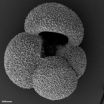(Press-News.org)
VIDEO:
Stanford physicist Ingmar Riedel-Kruse has begun developing "biotic games " involving paramecia and other living organisms. He hopes the games lead to advances in education and crowd-sourcing of laboratory research while...
Click here for more information.
Video game designers are always striving to make games more lifelike, but they'll have a hard time topping what Stanford researcher Ingmar Riedel-Kruse is up to. He's introducing life itself into games.
Riedel-Kruse and his lab group have developed the first video games in which a player's actions influence the behavior of living microorganisms in real time – while the game is being played.
These "biotic games" involve a variety of basic biological processes and some simple single-celled organisms (such as paramecia) in combination with biotechnology.
The goal is for players to have fun interacting with biological processes, without dealing with the rigor of conducting a formal experiment, said Riedel-Kruse, an assistant professor of bioengineering.
"We hope that by playing games involving biology of a scale too small to see with the naked eye, people will realize how amazing these processes are and they'll get curious and want to know more," he said.
"The applications we can envision so far are on the one hand educational, for people to learn about biology, but we are also thinking perhaps we could have people running real experiments as they play these games.
"That is something to figure out for the future, what are good research problems which a lay person could really be involved in and make substantial contributions. This approach is often referred to as crowd-sourcing."
Applying their lab equipment and knowledge to game development, Riedel-Kruse's group came up with eight games falling broadly into three classes, depending on whether players directly interact with biological processes on the scale of molecules, single cells or colonies of single cells.
The results of their design efforts are presented in a paper published in the 10th anniversary issue of Lab on a Chip (the first issue of 2011), published by the Royal Society of Chemistry. The paper is available online now.
Initially, Riedel-Kruse said, the researchers just wanted to see whether they could design such biotic games at all, so this first round of development produced fairly simple games.
"We tried to mimic some classic video games," he said. For example, one game in which players guide paramecia to "gobble up" little balls, a la Pac-Man, was christened PAC-mecium. Then there is Biotic Pinball, POND PONG and Ciliaball. The latter game is named for the tiny hairs, called cilia, that paramecia use in a flipper-like fashion to swim around – and in the game enables the kicking of a virtual soccer ball.
The basic design of the games involving paramecia – the single-celled organisms used in countless biology experiments from grade school classes to university research labs – consists of a small fluid chamber within which the paramecia can roam freely. A camera sends live images to a video screen, with the "game board" superimposed on the image of the paramecia. A microprocessor tracks the movements of the paramecia and keeps score.
The player attempts to control the paramecia using a controller that is much like a typical video game controller. In some games, such as PAC-mecium, the player controls the polarity of a mild electrical field applied across the fluid chamber, which influences the direction the paramecia move. In Biotic Pinball, the player injects occasional whiffs of a chemical into the fluid, causing the paramecia to swim one direction or another.
Riedel-Kruse emphasized that paramecia, being single-celled organisms, lack a brain and the capacity to feel pain. "We are talking about microbiology with these games, very primitive life forms. We do not use any higher-level organisms," he said. "Since multiple test players raised the question of exactly where one should draw this line, these games could be a good tool to stimulate discussions in schools on bioethical issues."
The game on the molecular level involves a common laboratory technique called polymerase chain reaction, or PCR, an automated process that lets researchers make millions of copies of an organism's DNA in as little as two hours.
In this game, called PolymerRace, the player is linked to the output of a PCR machine that is running different reactions simultaneously. While the reactions are running, the players can bet on which reactions will be run the fastest.
"The game PolymerRace is inspired by horse races, where you have different jockeys riding different horses," Riedel-Kruse said. "There is a little bit of biomolecular logic involved and a little bit of chance."
The third game uses colonies of yeast cells that players have to distinguish based on their bread-vinegar-like smell – an olfactory stimulus anyone can experience just by walking into a bakery.
"The idea is that while we as humans play the game, we interact with real biological processes or material," he said. His research group thinks that aspect of the games could help motivate children and even adults to learn more about biology, which is increasingly important to society.
"We would argue that modern biotechnology will influence our life at an accelerating pace, most prominently in the personal biomedical choices that we will be faced with more and more often," Riedel-Kruse said. "Therefore everyone should have sufficient knowledge about the basics of biomedicine and biotechnology. Biotic games could promote that."
Riedel-Kruse wants to maximize the educational potential of these games to enable lay people to contribute to biomedical research. The team hopes that by publishing his group's initial efforts, other researchers in the life sciences will be prompted to explore how their own research could be adapted to "biotic" video games.
Other researchers have developed biologically relevant Internet-based video games such as Fold-It, which lets players try different approaches to folding proteins, and EteRNA, developed in a collaboration between Stanford and Carnegie Mellon University, which lets players propose new molecular structures for ribonucleic acids (RNA).
Fold-It and EteRNA were developed to address specific research questions. Fold-It was strictly a simulation; and although EteRNA will actually test some proposed structures in the laboratory, the players themselves do not have direct interaction with biological processes in real time as in Riedel-Kruse's biotic games.
Part of Riedel-Kruse's continuing work will include close collaborations with Rhiju Das, an assistant professor of biochemistry at Stanford and one of the developers of EteRNA, and Daniel Schwartz, professor in the School of Education at Stanford. The three co-founded the "Bio-X.Game Center" to develop and apply biotic games to education and research.
INFORMATION:
Stanford researcher uses living cells to create 'biotic' video games
2011-01-15
ELSE PRESS RELEASES FROM THIS DATE:
Study provides molecular rationale for combining targeted agents to treat breast cancer
2011-01-15
COLUMBUS, Ohio – A new study by Ohio State University cancer researchers provides a rational for treating breast cancer by combining two kinds of targeted agents, one that inhibits an overactive, cancer-causing pathway in cancer cells and one that reverses changes that silence genes that normally prevent cancer. Both types of agents are currently available and being evaluated individually in clinical trials, the researchers note.
The findings, published online in the journal Cancer Research, show that abnormal activation of the PI3K/AKT signaling pathway leads to the ...
Earth's hot past: Prologue to future climate?
2011-01-15
The magnitude of climate change during Earth's deep past suggests that future temperatures may eventually rise far more than projected if society continues its pace of emitting greenhouse gases, a new analysis concludes.
The study, by National Center for Atmospheric Research (NCAR) scientist Jeffrey Kiehl, will appear as a "Perspectives" article in this week's issue of the journal Science.
The work was funded by the National Science Foundation (NSF), NCAR's sponsor.
Building on recent research, the study examines the relationship between global temperatures and high ...
More intensive methods needed to identify TB in HIV-prone populations
2011-01-15
Identifying tuberculosis patients in Africa using passive methods is leaving many cases undiagnosed, according to researchers from the Netherlands, Kenya and the United States, who studied case detection methods in HIV-prone western Kenya. Tuberculosis (TB) occurs commonly in men and women with HIV, but in these patients TB can be more difficult to detect.
The findings were published online ahead of the print edition of the American Thoracic Society's American Journal of Respiratory and Critical Care Medicine.
"Limited information exists on the prevalence of tuberculosis ...
Mandatory menu labeling didn't change behavior at 1 fast food chain
2011-01-15
DURHAM, NC and KING COUNTY, WA – An effort in King County, Washington, to add nutrition facts labeling to fast food menus had no effect on consumer behavior in its first year.
As part of a comprehensive effort to stem the rise in obesity, the county, which includes Seattle and environs, imposed a mandatory menu labeling regulation on all restaurant chains with 15 or more locations beginning in January, 2009. Restaurants had to disclose calorie information at the point of purchase.
Researchers from Duke-National University of Singapore (NUS) Graduate Medical School ...
Speeding up E. coli detection
2011-01-15
A simple, automated method of tracking E. coli uses a laser to detect and monitor the microbe in potentially contaminated bodies of water or waterways. The technique described this month in the International Journal of Computational Biology and Drug Design could reduce the incidence of waterborne disease outbreaks.
Microbial contamination of water is a worldwide environmental and health problem. Water related diseases are the leading causes of illness and death in the world. The impacts of water quality on public health and economy are highly significant as evidenced ...
Warming climate means red deer rutting season arrives early
2011-01-15
Wild red deer on the Isle of Rum, which were featured in the BBC TV series Autumnwatch, are rutting earlier in the year, a study shows.
Scientists believe the annual rutting season on the Isle of Rum could be changing because of warming spring and summer temperatures. The study shows that the rutting and calving seasons are now up to two weeks earlier on average compared with 30 years ago.
The research was based on a 38-year study of the ecology of red deer on the Isle of Rum and used annual records of breeding success in more than 3,000 individually recognisable ...
Heavy metals and pesticides threaten a Huelva wetland
2011-01-15
The Estero de Domingo Rubio wetland, located near the Marismas del Odiel Natural Area in the Huelva estuary, is regionally, nationally and internationally protected thanks to its ecological value. However, its tributary rivers and the Ría de Huelva estuary pump manmade pollutants into it, which could affect its water quality and ecosystem.
Industrial activity, accumulations of dangerous waste, the expansion of farming, and excessive extraction of sand and gravel for the construction industry are the leading threats to the Estero de Domingo Rubio wetland, the tidal system ...
Tractors rolling over is top cause of agricultural deaths
2011-01-15
The people in Spain at greatest risk of suffering farming accidents are those aged over 65, followed by people under 16 and people from outside the agricultural sector. These are the results of a study by the Public University of Navarre (UPNA), which shows that most of these deaths are due to people being crushed by tractors.
"Aside from recognised farming workers, other employees die in this sector and these deaths are not recorded. Our objective was to compare the real and official data on fatal farming accidents and to classify the most commonly associated risks", ...
Bioactive compounds in berries can reduce high blood pressure
2011-01-15
Eating blueberries can guard against high blood pressure, according to new research by the University of East Anglia (UEA) and Harvard University.
High blood pressure – or hypertension – is one of the major cardiovascular diseases worldwide. It leads to stroke and heart disease and costs more than $300 billion each year. Around a quarter of
the adult population is affected globally – including 10 million people in the UK and one in three US adults.
Published next month in the American Journal of Clinical Nutrition, the new findings show that bioactive compounds in ...
Dramatic ocean circulation changes revealed
2011-01-15
The unusually cold weather this winter has been caused by a change in the winds.
Instead of the typical westerly winds warmed by Atlantic surface ocean currents, cold northerly Arctic winds are influencing much of Europe.
However, scientists have long suspected that far more severe and longer-lasting cold intervals have been caused by changes to the circulation of the warm Atlantic ocean currents themselves.
Now new research led by Cardiff University, with scientists in the UK and US, reveals that these ocean circulation changes may have been more dramatic than ...




